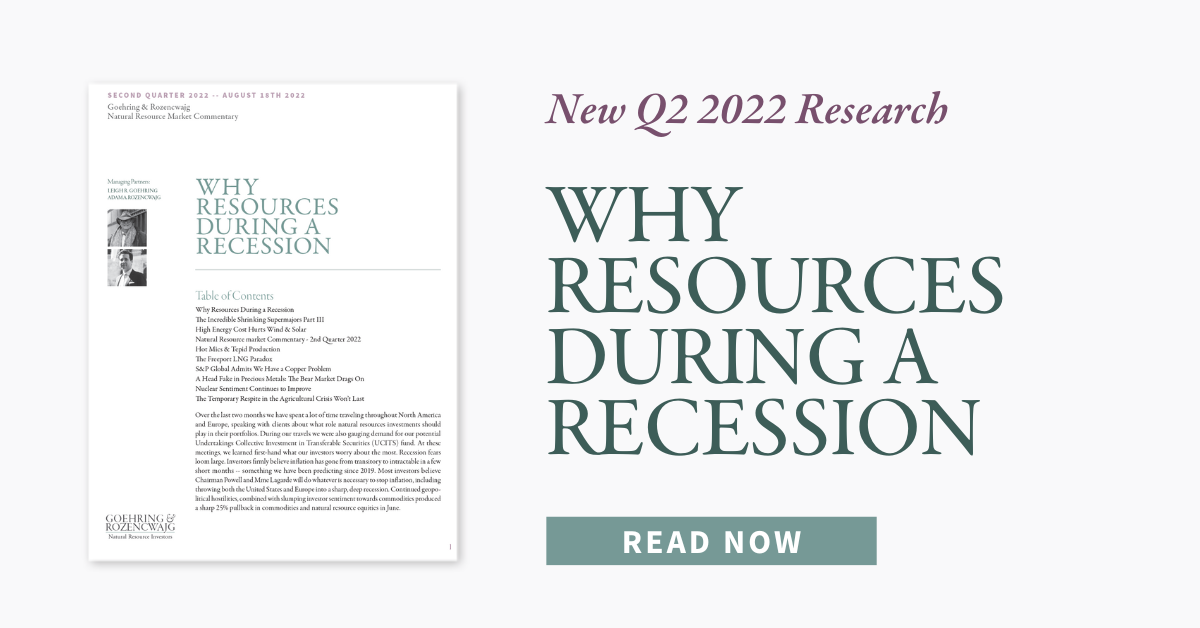The article below is an excerpt from our Q2 2022 commentary.
The global natural gas crisis has entered its most dangerous phase yet. We just returned from the UK, Switzerland, and Germany and the mood is dire. Most Germans now realize they will likely not secure adequate natural gas supplies to last the winter. Germanys’ Vice Chancellor and Federal Minister for Economic Affairs and Climate Action, Robert Habeck, recently warned of “catastrophic” industrial shutdowns in the coming months. As we write, one-month forward gas in the Netherlands is trading for $58 per mmcf – the equivalent of $360 crude oil.
For our North American readers, we cannot stress the extent to which natural gas fears have gripped the European continent. Whereas US media discuss the price of gasoline, throughout Europe the talk is of impending factory closures and the inability to heat homes come winter.
Putin has effectively weaponized Russia’s natural gas supply. In 2021, Russia exported 167 billion cubic meters of natural gas to Europe -- 30% of total demand. One third of this gas traveled along the Nord Stream I pipeline via the Baltic Sea into Germany and onwards to the rest of Europe. On July 10th, Russia shut the pipeline down for ten days of alleged routine maintenance. While Nord Stream returned to operation after ten days, on July 25th Gazprom announced it would reduce volumes to 20% of its capacity indefinitely.
European natural gas inventories have rebuilt to average seasonal levels but going forward major problems remain. First, European utilities have moved towards coal wherever possible to limit natural gas consumption. We estimate that 2022 EU coal demand will reach levels not seen since 1984. Despite trillions of dollars having been spent on renewable energy, the EU will likely emit more carbon this year than ever before. Even this strategy is proving challenging. Unexpected new demand has left inventories low and prices high. Global coal prices remain at record levels, with spot thermal coal prices above coking coal – something we can never recall seeing. Simply sourcing thermal coal remains challenging and could limit any further European consumption. In recent days, the Rhine has become impassable due to a persistent drought further adding to logistical bottlenecks.
Next, the cost. We estimate the cost of rebuilding Europe’s natural gas inventories this year could be more than ten times the average level. Already the economic consequences are having an impact, with feelings of energy nationalism and protectionism driving a wedge between European allies as the Ukrainian conflict drags on.
Third, the availability of LNG. We will discuss US gas fundamentals in a moment, but in Q2 the Freeport LNG export terminal was taken offline following a fire. Freeport produced 2 bcf/d of LNG or 20% of all US exports. Europe was counting on this demand and its loss could not have come at a worse time.
Last, European nuclear power output is now at short-term risk. Record heat in Europe has caused river temperatures to rise to levels that impair their ability to cool nuclear power plants. France has announced it would be curtailing some of its reactors which provide 70% of all electricity. While any such curtailments will be short lived and end as soon as the record temperatures abate, they too could not come at a worse time.
For all the concern over Russian pipeline imports, they have remained remarkably steady – until now. Until the recent Nord Stream curtailment, Russian volumes to Europe averaged approximately 200 million cubic meters per month. If Putin follows through with his threats and keeps volumes curtailed, the results could be truly catastrophic.
Europe started the year with inventories 53% full compared with 72% full on average – a deficit of 18 percentage points. After eight months of curtailing consumption, switching to coal wherever possible, and bidding record levels of any available LNG, inventories stand at 70% full – exactly average for this time of year. Were Putin to continue withholding natural gas, European utilities would have to reduce consumption by 30% or risk running out. The next few months will be critical.
Turning to the North American gas market, prices bottomed in late June at $5.40 per mmcf and have rallied back to $9.25. Even with the recent rally, US gas prices remain 86% below international prices. In our last letter, we explained why North American gas remain disconnected from world prices and why they could converge far quicker than any investors expect. In just six short years the US has gone from being an LNG importer to being the world’s largest LNG exporter. Now that the US has fully integrated itself into the global gas market, we argued that any disappointment in US dry gas production could quickly lead to a convergence of US prices with international prices.
No sooner than we wrote our essay, the Freeport LNG facility caught fire and was taken offline. Freeport has the capacity to produce nearly 2 bcf/d of LNG, representing 20% of total US export capabilities. When the news first broke on June 8th, Freeport was expected to be offline for two weeks. At the time, US natural gas inventories sat 310 bcf below the five-year seasonal average. The lost 2 bcf/d of Freeport exports over two weeks was only expected to amount to 30 bcf and would not materially change the inventory situation.
However, that significantly changed when Freeport announced a week later it would likely not restart before year end. Instead of adding a mere 28 bcf to inventories, the lost demand was now expected to add 360 bcf, eliminating the present inventory deficit entirely. Henry Hub gas prices promptly sold off on the news, ultimately reaching their lows of $5.40 per mmcf. While this did not change our longer-term bullish thesis, it did lessen the likelihood of a near term price spike the likes of which Europe experienced last fall.
Since then, there have been two extremely bullish developments. First, despite losing 2 bcf/d of export capacity, US inventory deficits have widened. In the eight weeks since the Freeport fire, over 100 bcf of LNG gas demand was lost. However, instead of inventories building relative to averages by a comparable volume, they have declined by 14 bcf. Hotter-than-average weather has taken gas in storage from 310 to 324 bcf below five-year averages. With hot weather expected to persist for at least the next week, we now expect inventories to remain very tight going into the winter.
Also, US gas supply growth continue to show limited growth. Between 2015 and 2020, US natural gas production surged. Driven by gas from the Marcellus, Haynesville, and associated gas from the Permian, production grew from 74 bcf per day to almost 94 bcf per day, or by approximately 4 bcf /day per year. Since the end of 2020, US growth in dry gas supply has slowed dramatically. As we wrote in our last letter, both the Marcellus and Haynesville shale gas plays were responsible for 18 of the 20 bcf/d growth we saw between 2015 and 2020. Monthly production data from both fields confirms that both are plateauing. We believe they will soon begin exhibiting declines. Marcellus dry gas production has shown zero growth over the last nine months and the Haynesville has been flat for six months. Also rig counts have stopped growing in both the Marcellus and Haynesville, another important data point suggesting our field analysis is correct. The rig count in the Marcellus has been flat for six months and is down almost 44% from its peak reached back in mid-2019, a sign that tier one drilling prospects are dwindling. The Hayneville rig count sits 20% higher than its 2019 peak; however, its rig count has been flat over the last six months.
With the announcement that Freeport will likely resume exports in October, much sooner than originally planned, combined with low inventories and a gas supply that has shown little in the way of growth, we believe the risk of a Q4 price spike in North American natural gas is once again high.
Natural gas has quickly gone from relative obscurity to geopolitical lynchpin. In the summer of 2020, seaborn LNG reached a low of $1.90 per mmcf while oil prices turned negative. Together, this represented the lowest energy costs in human history. Two short years later, LNG has risen 30-fold to $58 per mmcf, representing the highest energy costs in human history. Such is the result of a decade of underinvestment. Given the fragility of the world’s energy supply, it is no wonder tyrants and despots are moving to weaponize fuel sources. We do not expect this trend to stop and recommend investors position themselves accordingly. We remain extremely bullish on North American natural gas and recommend investors continue holding their natural gas related equities.
Intrigued? We invite you to revisit our entire Q2 2022 research letter, Why Resources During a Recession, available below.



